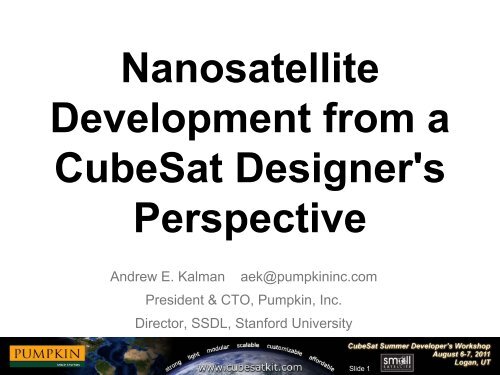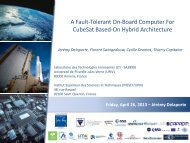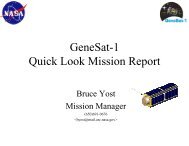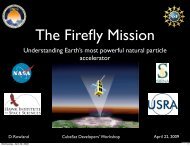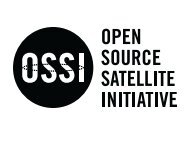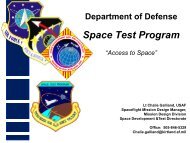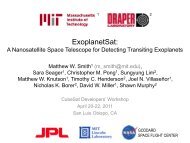Nanosatellite Development from a CubeSat Designer's Perspective
Nanosatellite Development from a CubeSat Designer's Perspective
Nanosatellite Development from a CubeSat Designer's Perspective
You also want an ePaper? Increase the reach of your titles
YUMPU automatically turns print PDFs into web optimized ePapers that Google loves.
<strong>Nanosatellite</strong><br />
<strong>Development</strong> <strong>from</strong> a<br />
<strong>CubeSat</strong> <strong>Designer's</strong><br />
<strong>Perspective</strong><br />
Andrew E. Kalman aek@pumpkininc.com<br />
President & CTO, Pumpkin, Inc.<br />
Director, SSDL, Stanford University<br />
Slide 1
CDS & P-POD<br />
• Twiggs @ Stanford: original <strong>CubeSat</strong> idea<br />
• Puig-Suari @ Cal-Poly: formalized idea, and<br />
developed deployer (P-POD)<br />
• CDS: Few-page standard<br />
• KISS: 10 x 10 x 10cm, few additional<br />
requirements<br />
• CDS now maintained at Cal Poly,<br />
http://www.cubesat.org<br />
Slide 2<br />
100.0 mm<br />
113.0 mm<br />
100.0 mm<br />
6.5 mm<br />
8.5 mm
Major <strong>CubeSat</strong> Components<br />
• Structure<br />
• Mechanisms<br />
• EPS<br />
• Batteries<br />
• Solar Panels & Arrays<br />
• C&DH<br />
• ADCS<br />
• COMM<br />
• Payload(s)<br />
• GSE<br />
• Software!<br />
Slide 3
Challenges in <strong>CubeSat</strong> Designs<br />
• Appearances can be deceiving – the small scale of<br />
<strong>CubeSat</strong>s complicates many design issues, rather than<br />
simplifies them<br />
• Volume envelope is severely constrained<br />
• Available power was severely constrained – impact on<br />
architectures, software, etc.<br />
• “Integer sizes” of various components (e.g., solar cells)<br />
don’t play well with certain <strong>CubeSat</strong> dimensions<br />
• No buying power, low volume<br />
• Limited budgets mean that design decisions have longreaching<br />
implications<br />
• Bias against <strong>CubeSat</strong>s as space debris<br />
Slide 4
Build vs. Buy<br />
• “Build a satellite” vs. “fly an experiment and get data”<br />
• Lots to learn in many disciplines when building<br />
• The more transparency (i.e., datasheets, CAD models, test<br />
results, responsiveness) the better, though said<br />
transparency, ISO9000, etc. do not guarantee quality or<br />
results<br />
• “Non-gifting” partners will often want to have clearly visible<br />
contributions<br />
• Value of free labor adds up quickly – difficult for successful<br />
small commercial entities to compete against this, both at<br />
the beginning (viewed as too expensive) and end of a<br />
project (when it’s too late to correct, no funds left)<br />
• Constraints due to ITAR<br />
Slide 5
Costs & Schedules<br />
• 1U kit (Pumpkin): $7500<br />
• 1U launch: was $40k, now ???<br />
• 1U mission (complete): $
Iterating Towards a Solution<br />
• Must always consider the entire system – holistic design<br />
has many dimensions and drivers<br />
• C1B spec was relatively open, therefore requirements<br />
that affected “free” portions of design were fluid and took<br />
time to converge<br />
• Version history becomes an institutional asset<br />
• Simpler is better, but not every solution is simple<br />
Slide 7
CAD Must be Perfect<br />
• Everything gets modeled in 3D CAD … don’t take<br />
anything (e.g., price, specs, availability, etc.) for granted<br />
• Nothing goes into<br />
production until CAD<br />
is fully vetted … too<br />
dangerous to do otherwise<br />
• Permits many “what if”<br />
scenarios<br />
• Has additional benefits:<br />
• Illustrations<br />
• Mass estimates<br />
• Models for customer use<br />
• 3-D printing<br />
• Scale independence<br />
Slide 8
Quality Matters<br />
• No changes or mods to any<br />
Pumpkin-designed or produced<br />
component required over life of<br />
C1B program<br />
• Good design is fundamental to<br />
quality<br />
• Concurrent<br />
builds ease<br />
quality<br />
assurance<br />
Slide 9
<strong>CubeSat</strong> Architectures<br />
• Hardware:<br />
• Microcontroller-based (CP, GeneSat, CSK, etc.)<br />
• Microprocessor-based<br />
• Proprietary (CSTB)<br />
• SBC-based (QuakeSat)<br />
• General-purpose (CSK)<br />
• Specific-purpose (LANL)<br />
• FPGAs & rad-hard<br />
• Concentrated or distributed processing<br />
• Software<br />
• C programming<br />
• Simply embedded vs. PCs<br />
• Multi-processor or multitasking (RTOS)<br />
• Reliance on libraries, etc.<br />
Slide 10
Hardware vs. Software<br />
• Hardware & software co-design required for successful<br />
overall system design<br />
• Hardware – once stable – incurs few costs as program<br />
progresses. Good hardware design practices rare<br />
amongst unseasoned designers. Requires vendor &<br />
inventory management (VIM) for longer-term<br />
sustainability<br />
• Modularity and well-defined ICDs can mitigate problems<br />
& isolate design efforts<br />
• Software creep must be aggressively managed<br />
• Software deliverables should be tested & vetted<br />
incrementally (e.g., N x per quarter)<br />
Slide 11
<strong>CubeSat</strong> Generations<br />
•1 st : Modern Sputniks<br />
•2 nd : Utility of the 3U is<br />
demonstrated<br />
•3 rd : More power, attitude control<br />
& determination, propulsion<br />
•4 th : Constellations<br />
Slide 12
Interdisciplinary <strong>Development</strong><br />
• SSDLCAM:<br />
• CAD Team<br />
• Electronics Team<br />
• Embedded f/w team<br />
• SBC (Linux) team<br />
• Camera Integration Team<br />
• Experiments Teams<br />
• Applications Team<br />
• Etc.<br />
Slide 13
Interdisciplinary<br />
Teaming (External)<br />
• SSDL (bus)<br />
• JPL (ITAR payload)<br />
Slide 14
Interdisciplinary<br />
Teaming (Internal)<br />
• SSDL (camera + FMR exp.)<br />
• HEPL (UV LED exp.)<br />
• STARLab (EED exp.)<br />
• Pumpkin: equipment<br />
donations, advising<br />
Slide 15
Interdisciplinary<br />
Teaming (Summer)<br />
• SSDL (payload)<br />
• Aeropac & ARLISS (sponsors)<br />
Slide 16
Why <strong>CubeSat</strong>s drive Tech Innovation<br />
• Short development timeframes – ride the wave<br />
• Proven use of mass-produced components – antithesis of<br />
“approved space components” builds<br />
• Relatively low cost means launch & other failures not a<br />
major obstacle<br />
• Dynamic response to problematic issues (e.g., deorbit)<br />
• Currently protected by “LEO or lower” orbits<br />
Slide 17
Trends / Hot Topics<br />
• Earth Imaging<br />
• Space Weather<br />
• (Android) PhoneSats<br />
• More & Better Power<br />
• Faster Comms<br />
• Propulsion at Last!<br />
• What is the killer app?<br />
Slide 18
Q&A Session<br />
Thank you for<br />
attending this<br />
Pumpkin<br />
presentation at the<br />
2011 <strong>CubeSat</strong><br />
Summer Developers<br />
Workshop!<br />
Slide 19
Notice<br />
This presentation is available online in Microsoft ®<br />
PowerPoint ®<br />
and Adobe ®<br />
Acrobat ®<br />
formats at:<br />
and:<br />
www.pumpkininc.com/content/doc/press/Pumpkin_CSDWLU_2011-1.ppt<br />
www.pumpkininc.com/content/doc/press/Pumpkin_CSDWLU_2011-1.pdf<br />
Slide 20
Appendix<br />
• Speaker information<br />
� Dr. Kalman is Pumpkin's president and chief technology architect. He entered the embedded programming<br />
world in the mid-1980's. After co-founding Euphonix, Inc – the pioneering Silicon Valley high-tech pro-audio<br />
company – he founded Pumpkin, Inc. to explore the feasibility of applying high-level programming paradigms to<br />
severely memory-constrained embedded architectures. He is the creator of the Salvo RTOS and the <strong>CubeSat</strong><br />
Kit. He holds several United States patents. He is a consulting professor in the Department of Aeronautics &<br />
Astronautics at Stanford University and directs the department’s Space Systems <strong>Development</strong> Laboratory<br />
(SSDL). Contact Andrew at aek@pumpkininc.com.<br />
• Acknowledgements<br />
� Pumpkin’s Salvo, <strong>CubeSat</strong> Kit and MISC customers, whose real-world experience with our products helps us<br />
continually improve and innovate.<br />
• <strong>CubeSat</strong> Kit information<br />
� More information on Pumpkin’s <strong>CubeSat</strong> Kit can be found at http://www.cubesatkit.com/. Patented and Patents<br />
pending.<br />
• Copyright notice<br />
© 2000-2011 Pumpkin, Inc. All rights reserved. Pumpkin and the Pumpkin logo, Salvo and the Salvo logo, The<br />
RTOS that runs in tiny places, <strong>CubeSat</strong> Kit and the <strong>CubeSat</strong> Kit logo, <strong>CubeSat</strong> Kit Bus, nanoLab Kit and the<br />
nanoLab Kit logo, and MISC are all trademarks of Pumpkin, Inc. Don’t leave Earth without it is a service mark<br />
of Pumpkin, Inc. All other trademarks and logos are the property of their respective owners. No endorsements<br />
of or by third parties listed are implied. All specifications subject to change without notice. Unless stated<br />
otherwise, all photographs, images and illustrations are the property of Pumpkin, Inc. and may not be used<br />
without permission.<br />
First presented at the <strong>CubeSat</strong> Developers’ Workshop in Logan, Utah on Sunday, August 7, 2011, prior to the 25 th<br />
Annual AIAA/USU Conference on Small Satellites.<br />
Slide 21


